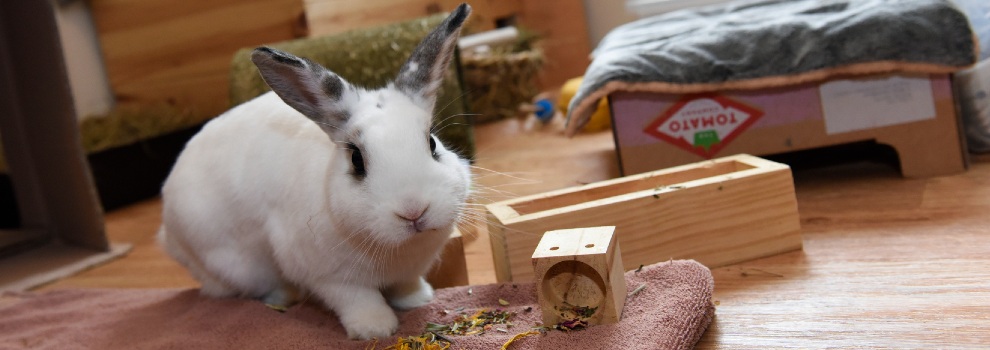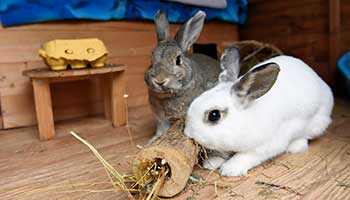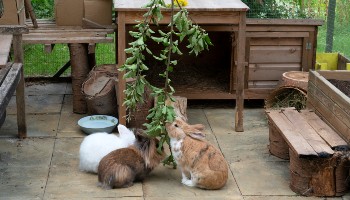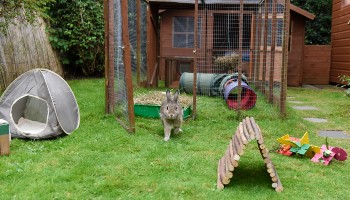Whether your rabbits live inside or outside, their five basic welfare needs must be met. These are a healthy diet, a suitable place to live, protection from pain and suffering, the right company, and the opportunity to behave normally. You’ll need to take extra care to protect house rabbits from hazards, such as toxic materials and electric wires.
Read on for advice on deciding whether keeping your rabbits indoors is right for you and your pet and how to make sure they’re safe, happy and healthy. We also explain how to move outdoor rabbits indoors during the winter months without causing them undue stress.
Is indoor living right for my rabbit?
Each rabbit is an individual and your decision should take into account your animal's temperament, previous lifestyle and experience. Also consider if you can meet your rabbit’s needs within your home. There’s much more on this below.
When it’s not a good idea
Some rabbits are fearful of humans, especially when they’re under-socialised or have had negative experiences, which is true for many rescue rabbits. For these, living in your home could be very stressful, particularly if they’re used to living outdoors. It might also be difficult to give rabbits the peace and quiet they need in your home, if there's limited space or childen or other pets around.
An animal behaviourist may be able to help you gradually build up your rabbit’s confidence around people.
Safety
A key issue to consider is your rabbits’ safety. Every rabbit, every owner and every situation is different, but you need to ensure your rabbits are safe and protected from hazards. You'll also need to fully rabbit-proof all areas your rabbits can get to. Dangerous areas, such as near the oven, should be blocked off.
Rabbits love to chew, so electric cables and wires must be covered or put out of reach. Houseplants should be non-toxic or placed up high. Check that leaves and petals won’t fall into areas the rabbits have access to. We have more information on accidental poisoning.
To keep them safe, we'd advise you to always supervise your rabbits when you let them out of their secure enclosure.
Rabbits don't like extreme temperatures
The ideal temperature for rabbits is between 10 and 20 degrees Celcius. Rabbits can suffer from heat stress and get very ill if exposed to high temperatures. And as domestic rabbits don't have the thick fur of wild rabbits, they don't like it to be too cold. Make sure your rabbits’ home is placed away from draughts, radiators and fires.
A safe enclosure
Your rabbits will need a large, safe enclosure in a calm, quiet part of your home where they won't be disturbed. This needs to include a main shelter and a secure exercise area. This could be a large, adapted dog pen/crate, a large hutch and run complex, or a rabbit-proofed room that has at least one shelter to act as a darkened sleeping/resting area. The sleeping area must be large enough for all the rabbits in case they chose to sleep or rest together. You should also provide a number of hiding spots – one for each rabbit plus an extra one. That way all the rabbits can chose to have some alone time.
The enclosure gives your rabbits a safe, familiar place to rest. It must be large enough and interesting enough for the rabbits to be able to behave normally, exercise and play.
The floor of the rabbits' enclosure (and ideally all areas the rabbits have access to) should be solid and non-slip. Please note that shiny/polished laminate or wooden flooring and tiles can be slippery and stressful for rabbits. To help, either cover this flooring with newspaper or ensure your rabbit can’t get to those areas. Avoid mesh flooring as it can lead to problems with rabbits' feet.
Settling them in
When your rabbits first move into your home, we suggest that you leave them within their enclosure for at least 48 hours. This gives them time to get used to new sounds and smells while feeling safe, as well as getting used to increased contact with people and other household pets. It also helps the rabbits get used to where their litter trays are (if provided) and help with litter training.
You can help your rabbits feel at ease by putting familiar smelling items in their new environment such as toys, used but unsoiled bedding, and a water bottle.
If you've kept rabbits before, make sure you don't reuse any of their bedding, even if it's clean. And clean any enrichment items, including toys and hiding places, before the new rabbits arrive. Rabbits are territorial and can find the scent of other, unfamiliar rabbits stressful.
There is help available. Rescue centre staff, vets and qualified animal behaviourists can all give you advice on helping rabbits adapt to an indoor environment.
Outside exercise
Ideally, you'll be able to put your house rabbits outside regularly for exercise in the warmer months. They'll be able to practise behaviours such as digging and grazing on growing grass. Their secure enclosure should include a shelter, enrichment items and hiding places.
A word of caution, though. Rabbits don't cope well with sudden changes in temperature, even in spring and summer, so avoid taking them outside to exercise until it's at least 10 degrees Celcius. Once the temperature is heading towards 20 degrees or if it's sunny, provide plenty of shade for them. In warmer weather, move your rabbits to a shady area or even into an unused garage or outbuilding, as this protects them from sunstroke.
Enrichment
Rabbits need to be given opportunities to stay active and exhibit natural behaviours that they would show in the wild – such as foraging, grazing and digging. You can make their environment more interesting and help keep them busy, physically and mentally by adding ‘enrichment’. This can include hiding places, toys and platforms, as well as the way you give them food.
Keeping your rabbit busy and stimulated will make them less likely to chew your fixtures and fittings. Even indoors, you can encourage them to dig by giving them a ‘dig box’ – a tray or cardboard box filled with shredded paper or child-safe sand. You can also grow grass in trays or pots so they can graze indoors.
Rabbits need company
Rabbits are social animals and like to live with at least one other compatible rabbit. They’re also known to form bonds with their owners. Spending a lot of time with your rabbits can help you form a more rewarding relationship, which will be beneficial for both of you. Even so, it's important to remember that human contact can't take the place of the company of another rabbit. Rabbits need contact with other rabbits.
If your vet recommends that your rabbit is best kept alone, please seek advice on what you can do to make sure your rabbit's welfare needs are being met.
Other pets
If you have other pets, you need to make sure they don’t harm or frighten your rabbits. As prey animals, rabbits will usually be scared of cats and dogs as these are their natural predators. If you introduce them carefully they can develop friendships, but even if you think your pets are good friends you should never leave them together unsupervised.
Training
Rabbits are intelligent and can be taught to respond to commands with some positive reward-based training, such as clicker training. Never get angry with your rabbits or punish them. They won’t understand and it can make them stressed and fearful. Instead, be patient and try to make simple training a part of your daily routine.
Litter training
Rabbits can be litter trained. In the wild, they naturally create toileting areas for urine and droppings, and use them to mark territory and communicate with other rabbits. Pet rabbits will often choose a particular corner or corners of their home to use as a toilet. They'll need access to their toilet areas at any time because once they're used to going to the toilet in one place they won't want to use another. And if they don't go for a while, it can become a medical emergency.
Please note that toilet areas should be away from the sleeping area and that rabbits need to be able to access their toilets areas at any time.
Litter training should take place in the rabbits' usual enclosure. Encourage your rabbits to toilet in specific trays by adding some used litter material and droppings. Ideally, there will be one tray per rabbit plus one extra. Use newspaper, hay or straw, shredded paper and/or paper-based non-clumping, non-expanding cat litter.
Moving from outside to inside, and back again
Some owners house rabbits outside during the spring and summer months but move them indoors in the winter, where it's warmer and easier to keep an eye on them. It's important to minimise the stress for your rabbits, so you need to think carefully about their needs when moving them from one environment to another.
The indoor environment is very different to your rabbits' outdoor home. There'll be lots of changes for them to get used to, such as new sights and sounds and potential changes to their routine and housing. Introduce your rabbits to their new home gradually by bringing them indoors for increasingly longer periods each day during the summer and autumn. That way they can settle in and explore their new surroundings before moving back into the house full time.
Follow our advice above for setting up your rabbits indoors. In this case, you can help them adjust to the change from natural daylight hours to artificial light by gradually increasing the length of time the lights are on in the evenings. They'll need a darkened sleeping area where they can rest whenever they choose.
Moving back outside
When returning rabbits to their outside home after winter, wait until the days are warmer (at least 10 degrees Celcius) and gradually increase the amount of time your rabbits spend outside. Keep them in their indoor home at night if temperatures are low. You could even put their home in a shed, outhouse or unused garage to get them used to milder temperatures before finally placing their home outside.




